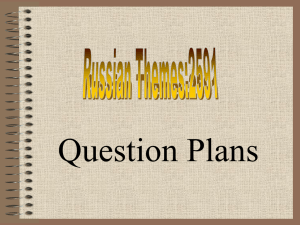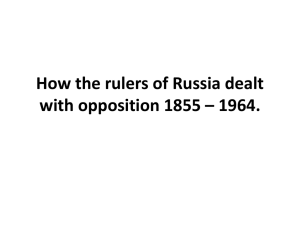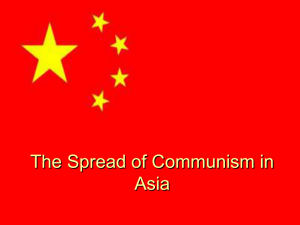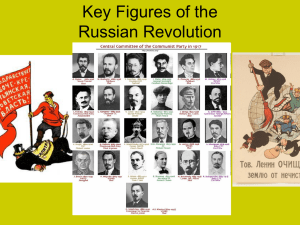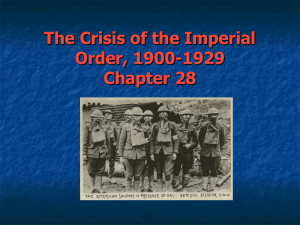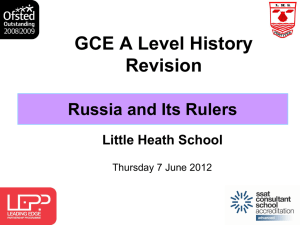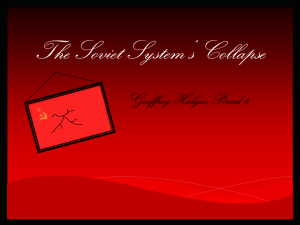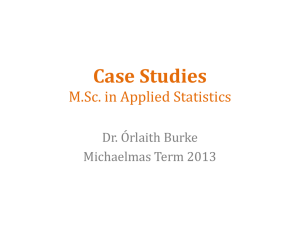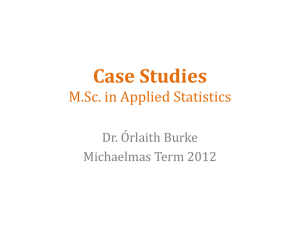Russian Government revision
advertisement
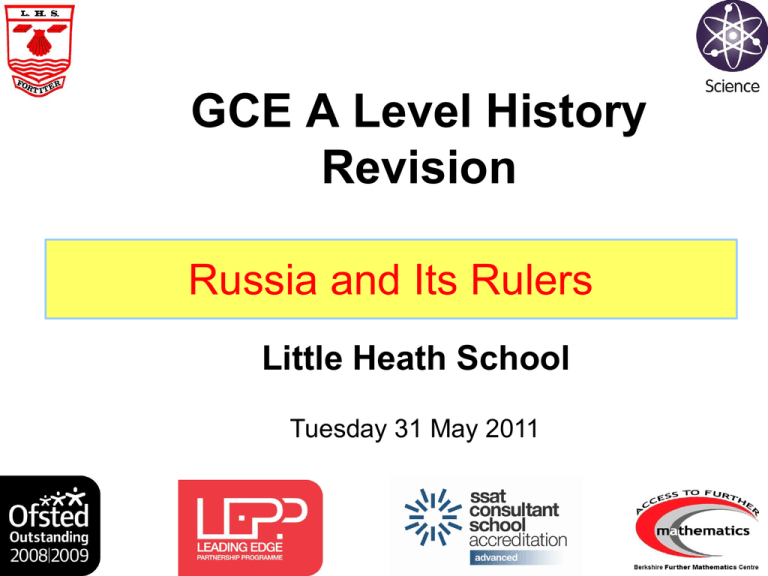
GCE A Level History Revision Russia and Its Rulers Little Heath School Tuesday 31 May 2011 Russia and Its Rulers – Government styles before / after 1917 Aims – what did each ruler want to achieve Methods – how did each ruler rule; their policies (reform / repression) Outcomes – how successful was each ruler in achieving their aims Essays asking whether one ruler was better than the rest at ‘something specific’. – TURNING POINT essays especially related to turning points in how Russia was governed Tsar Alexander II 1855 - 1881 Aims, Methods & Outcomes AIMS • To secure the throne: • Make himself, the Romanov Dynasty and autocracy more popular. METHODS • Reform ‘from above’ OUTCOMES • Alexander II faced a rising tide of opposition and ultimately the Peoples Will assassinated him in 1881. Turning Points • An good case could be made that Alexander II’s accession to the throne in 1855 was a significant turning point in the government of Russia. His decision to ‘reform from above’ led to the Emancipation Edict in 1861. In one fell swoop he ended serfdom and brought Russia and its peasants out of mediaeval feudalism. • This case is flawed. The inadequacies of emancipation were quickly apparent. The lives of the peasants remained grim as exemplified by the famine of 1891. • For the purposes of an essay about RUSSIAN GOVERNMENT is it relevant? Turning Points • In 1881 the assassination of Alexander II, the ‘Tsar Liberator’, brought a final end to the period of reform dominated by his emancipation of the serfs in 1861. His successor, Alexander III, ruled repressively and autocratically; his reign is often referred to as ‘the Reaction’. • It has been argued that the assassination of Alexander II marked the last chance that the Romanovs might reform sufficiently to save their doomed dynasty. This argument has some validity but Alexander II, faced with a rising tide of opposition abandoned any serious attempt to reform and modernise Russia long before the Peoples Will sentenced him to death. Tsar Alexander III 1881 - 1894 Aims, Methods & Outcomes AIMS • To secure the throne: • To restore traditional autocracy. METHODS • The ‘Reaction’ – increased repression • But allowed Witte to commence ‘the Great Spurt’ OUTCOMES • Re-established secure government (but Trotsky argued that Alexander III ‘bequeathed Nicholas II a revolution’). Turning Points • Alexander III’s reactionary policies restored stability during his reign, but as Trotsky has argued, his legacy to Nicholas II was to be the revolutions of 1905 and 1917. • The Romanovs were on collision course with catastrophe; Alexander II’s assassination was a significant event but it was not the most important turning-point in the development of Russian government in this period. Tsar Nicholas II 1894 - 1917 Rasputin Aims, Methods & Outcomes AIMS • To secure the throne: • To maintain traditional autocracy. • To ‘rule like my late, unforgettable father’. METHODS • Repression • Reform (when forced into it by revolution) OUTCOMES • Abdication in February 1917 and ending of the Romanov dynasty (and of autocracy) Turning Points • The Russian Revolution of 1905 led to the October Manifesto, the apparent abandonment of autocracy and introduction of a constitution & the formation of the Duma, 4 of which existed between 1906 and 1917. • It could be argued that this was an important turning-point in the development of Russian government because it was the only period in which Russian government deviated from its autocratic / dictatorial norm. • However, Nicholas II’s announcement of the Fundamental Laws and reassertion of autocracy before the Duma had even sat, his sacking of the first two Dumas within months of the elections and his blatant rigging of subsequent elections for the third and fourth Dumas all suggest that this was a façade. • Nicholas II announced the October Revolution as a ‘divide and rule’ strategy to avoid being overthrown in 1905. The differences this made to the reality of absolute rule were negligible and short-lived. Turning Points • The revolutions of 1917 profoundly changed the course of Russian history, ending the Romanov dynasty and creating the world’s first communist state. Even if Berdiaev was correct when stating that ‘All of the past is repeating itself, and acts only behind new masks’, this was a fundamental change of significant importance in Russian and world history. • The replacement of autocratic Tsarism with the world’s first communist government during the revolutions of 1917 was of major importance. By 1956 a significant part of the world was communist and predominantly under the direct influence of the USSR. All of this was a direct result of the events of 1917 and the Bolshevik seizure of power. From Autocracy (or did that end in 1905) February (March) - October (November) 1917 THE PROVISIONAL GOVERNMENT To Communist Dictatorship Aims, Methods & Outcomes AIMS • Democracy • A temporary (provisional) government until elections for a Constituent Assembly could be held. METHODS • Greater freedoms / liberal reforms • But stayed in the WAR and failed to re-distribute the land OUTCOMES • Overthrown by the Bolsheviks in October (Lenin’s slogan: ‘Peace, Bread and Land’). Turning Points • The ending of autocracy when Nicholas II abdicated in February 1917 gave Russian Government a window of opportunity in which to develop a constitutional and democratic model. • However the Provisional Government made so many mistakes that it was swept aside in October before the planned elections to the new Constitutional Assembly could take place. Lenin 1917 - 1924 Aims, Methods & Outcomes AIMS • To secure power • To introduce communism / Marxism • To modernise Russia and catch up with the West METHODS • The ‘dictatorship of the proletariat’ • But key reforms in 1917 and again in 1921 (NEP) OUTCOMES • Communists securely in power by 1924 when Lenin died Turning Points • Lenin seized power in October 1917, finally ending the liberal dream that Russia might develop a constitutional / democratic government in the period studied. • He established the world’s first communist state and destroyed the power of the old elites – the Russian Orthodox Church and the landowning class; everyone was a ‘comrade’ now; • However his dictatorial style of government, including his banning of factions in the Communist Party and crushing of the Kronstadt Revolt owed much to the ‘autocratic’ model. Stalin c.1924 - 1953 Aims, Methods & Outcomes AIMS • To secure power • To defeat and eliminate all possible rivals • To modernise Russia and catch up with the West METHODS • Terror, Show Trials and purges • The Five Year Plans and collectivisation OUTCOMES • The USSR was victorious in the Second World War and was challenging the USA in the Cold War when Stalin died in 1953 Turning Points • Stalin’s rise to power was of immense significance. • Stalin’s acquisition of total power had a huge impact as the countless victims of de-kulakisation, the terror, the gulags and the Show Trials could testify. As Khrushchev admitted in 1956 under Stalin ‘Soviet citizens came to fear their own shadows’. Stalin’s betrayal of the principles of the revolution led to what Lynch has described as ‘the replacement of one form of state authoritarianism by another’. • Since the opening up of the old Soviet archives many historians now claim that Stalinism grew directly out of Leninism, Volkogonov, stating: ‘everything done in Russia after Lenin’s death was done according to his blueprint’. Khruschev c.1954 - 1964 Aims, Methods & Outcomes • • • • • • AIMS To secure power in power struggle after Stalin’s death To defeat and eliminate all possible rivals To modernise Russia and catch up with the West METHODS De-Stalinisation (the ‘Secret Speech’, 1956) Changed industrial focus to include consumer goods OUTCOMES On 14th October, 1964, the Communist Party Central Committee forced Khrushchev to resign. Turning Points • Khrushchev’s announcement of de-Stalinisation in his ‘secret speech’ of 1956 promised the Russian people reform from above. • Khrushchev’s ‘Thaw’ was a welcome respite after the brutal excesses of Stalin but his reforms didn’t lead to a significant overhaul of the communist system. • In 1956 Khrushchev crushed the Hungarian Revolt despite his criticisms of Stalin’s regime and his announcement of ‘peaceful co-existence’.
